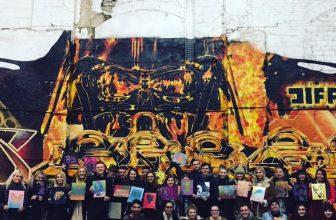
Standing at Dublin Airport’s arrival gate, watching my teenagers emerge from their first transatlantic flight, I felt that familiar pre-trip flutter of excitement mixed with mild panic. How were we going to navigate Ireland’s capital city with teens in tow and absolutely no intention of renting a car?
The thought of driving on what I stubbornly consider “the wrong side of the road” while simultaneously trying to navigate narrow Dublin streets and keep my kids engaged was enough to make me book our entire Irish adventure around public transport and walkable experiences. And you know what? It turned out to be one of the best travel decisions I’ve ever made.
This article contains affiliate links. We earn from qualifying purchases.
Dublin isn’t just manageable without a car, it’s actually better. The city’s compact size, excellent public transport, and walkable historic center make it perfect for families who want to dive deep into Irish culture without the stress of international driving. Over three incredible days, we discovered that staying centrally located and embracing Dublin’s pedestrian-friendly layout opened doors to authentic experiences we never would have found from behind a steering wheel.
From touching down via Aircoach to exploring castle dungeons, from sampling whiskey history to watching an unexpected parade honoring Ireland’s emergency services, our car-free Dublin adventure proved that sometimes the best family trips happen when you slow down, walk more, and let the city reveal itself at a more human pace.
🍀 Perfect For These Families
This itinerary is ideal for:
- Families with teenagers (ages 13-18) who can walk 2-3 miles daily
- Parents nervous about driving in Ireland
- Travelers who prefer authentic, walkable experiences over rushed sightseeing
- Families looking for a perfect introduction to Irish culture and history
Why it works: Dublin’s compact city center means major attractions are within 15-30 minutes’ walk of each other. Staying centrally eliminates transportation stress while maximizing exploration time.
Where to Stay: The Mont Hotel near Trinity College is perfectly situated near transit stops and within walking distance of top attractions and sites. It’s a comfortable stay in a quiet location.
Book These Experiences:
Note: We, once again, worked with Tourism Ireland during this trip to receive comped experiences and accommodations for research purposes. All opinions are our own.

Getting to Dublin & Why Central Accommodation Changes Everything
The moment our Aircoach bus pulled away from Dublin Airport, I knew we’d made the right choice. No rental car paperwork, no GPS anxiety, no teenage backseat complaints about my driving. It’s just a comfortable, affordable ride straight into the heart of Dublin.
The Aircoach service runs every 10-15 minutes from Dublin Airport to the city center, costing about €8 per person. Our destination was the O’Connell Street stop, a short walk from The Mont Hotel. Watching my teens effortlessly navigate the short walk with their luggage while chatting excitedly about our upcoming adventures, I realized we’d already won the first challenge of international family travel: arriving without stress.
Why The Mont Hotel Near Trinity College Was Perfect:
Location is everything when traveling, especially with children or teenagers, and The Mont Hotel‘s position on Merrion Street Lower put us within walking distance of virtually every major Dublin attraction. Trinity College was across the street, Dublin Castle was a 20-minute stroll, and Temple Bar’s daytime attractions were easily accessible on foot.
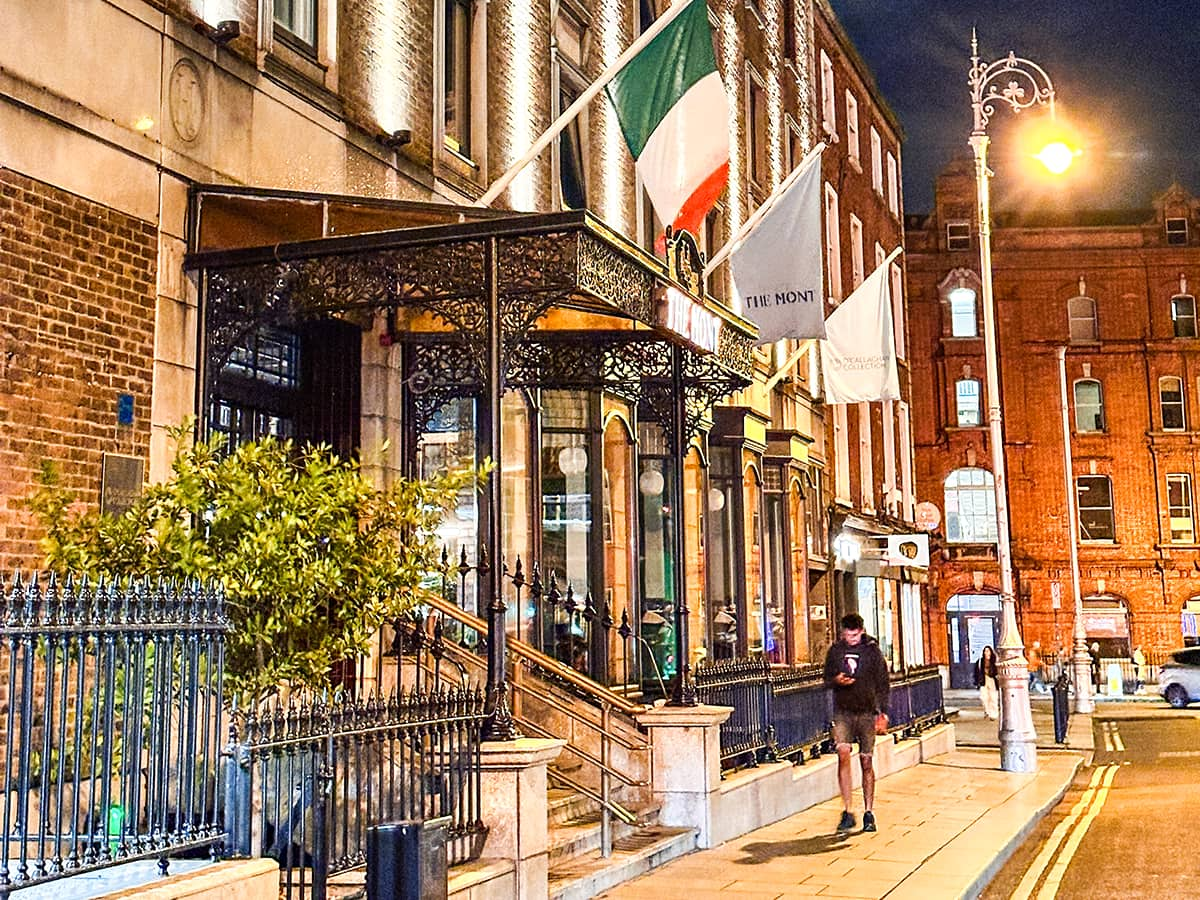
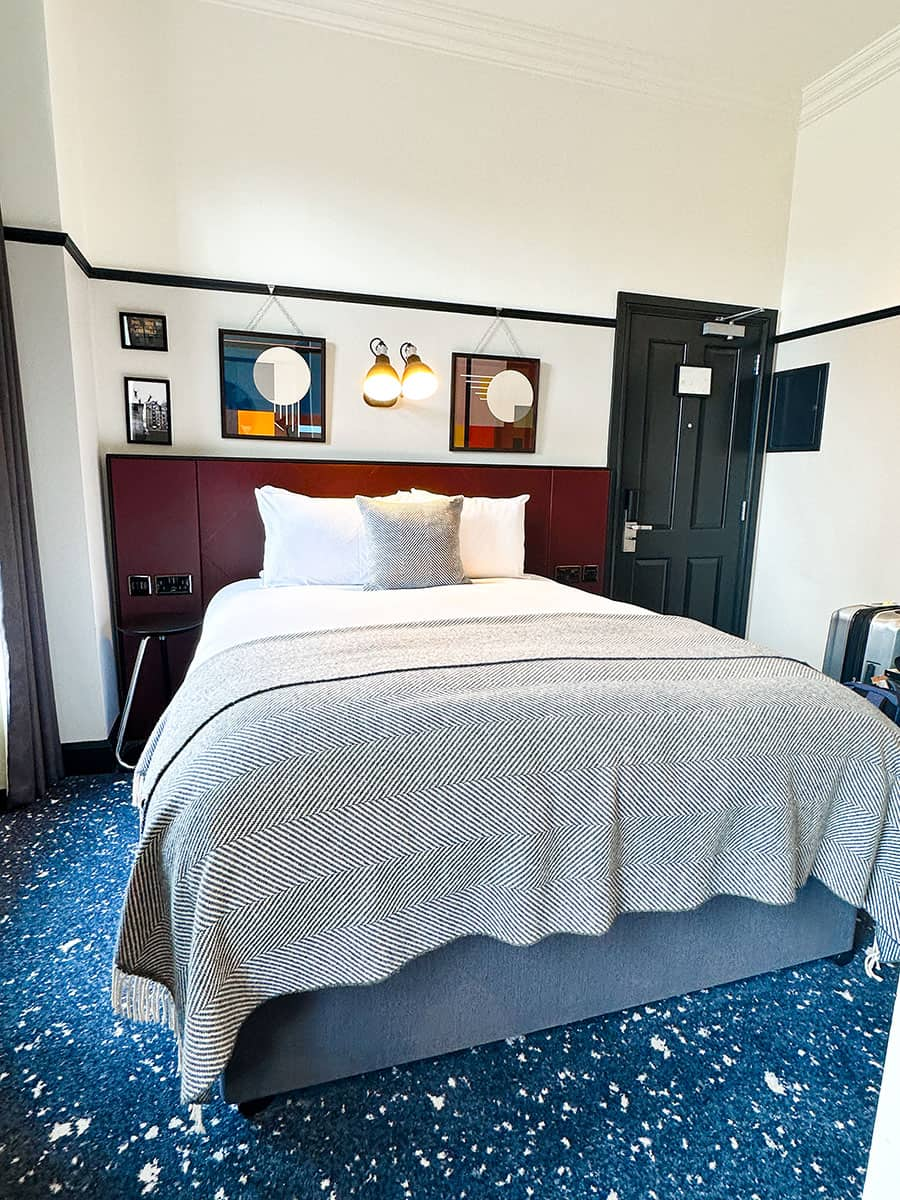
More importantly, the hotel’s stellar breakfast gave us the perfect start to each adventure-packed day. The breakfast at The Mont deserves special mention. Think traditional Irish breakfast meets modern hotel elegance, with enough variety to satisfy even the pickiest teenage eater. Starting each day with a proper meal meant we could walk for hours without anyone getting “hangry,” a crucial factor in successful teen travel.
Note: On my previous visit to Dublin, I stayed at the Trinity City Hotel on the other side of the college. Read about that Dublin one day itinerary here.
Day 1: Arrival and Whiskey History at Jameson Distillery
After settling into our room, we set off for our first real Dublin experience: the Jameson Distillery Bow Street. The 30-minute walk through Dublin’s streets provided the perfect introduction to the city’s rhythm and character.
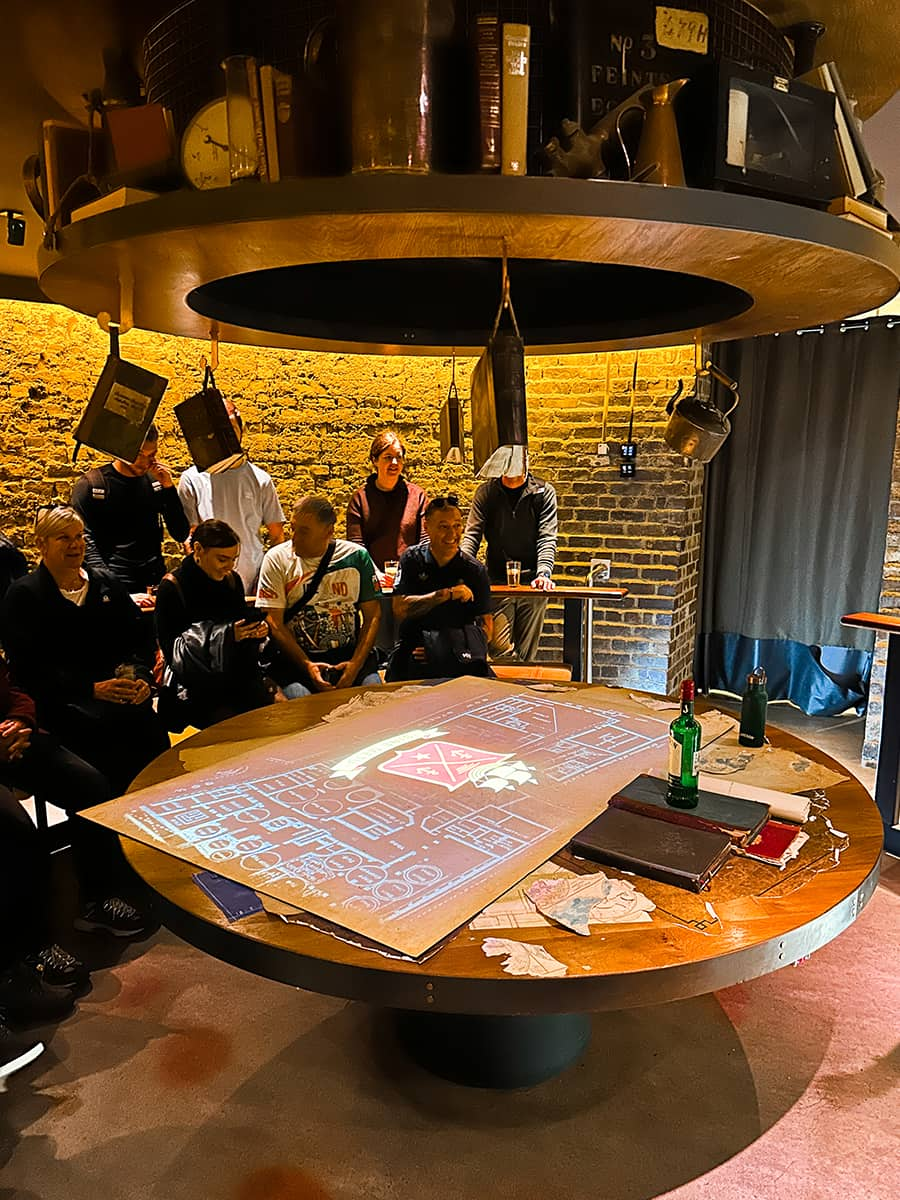
What made Jameson Distillery perfect for teens:
Despite what you might think, a whiskey distillery tour is surprisingly engaging for teenagers ages 13 and up. The Jameson experience focuses heavily on Irish history, storytelling, and interactive exhibits rather than just alcohol production. Adults 18 and over can try the actual spirits.
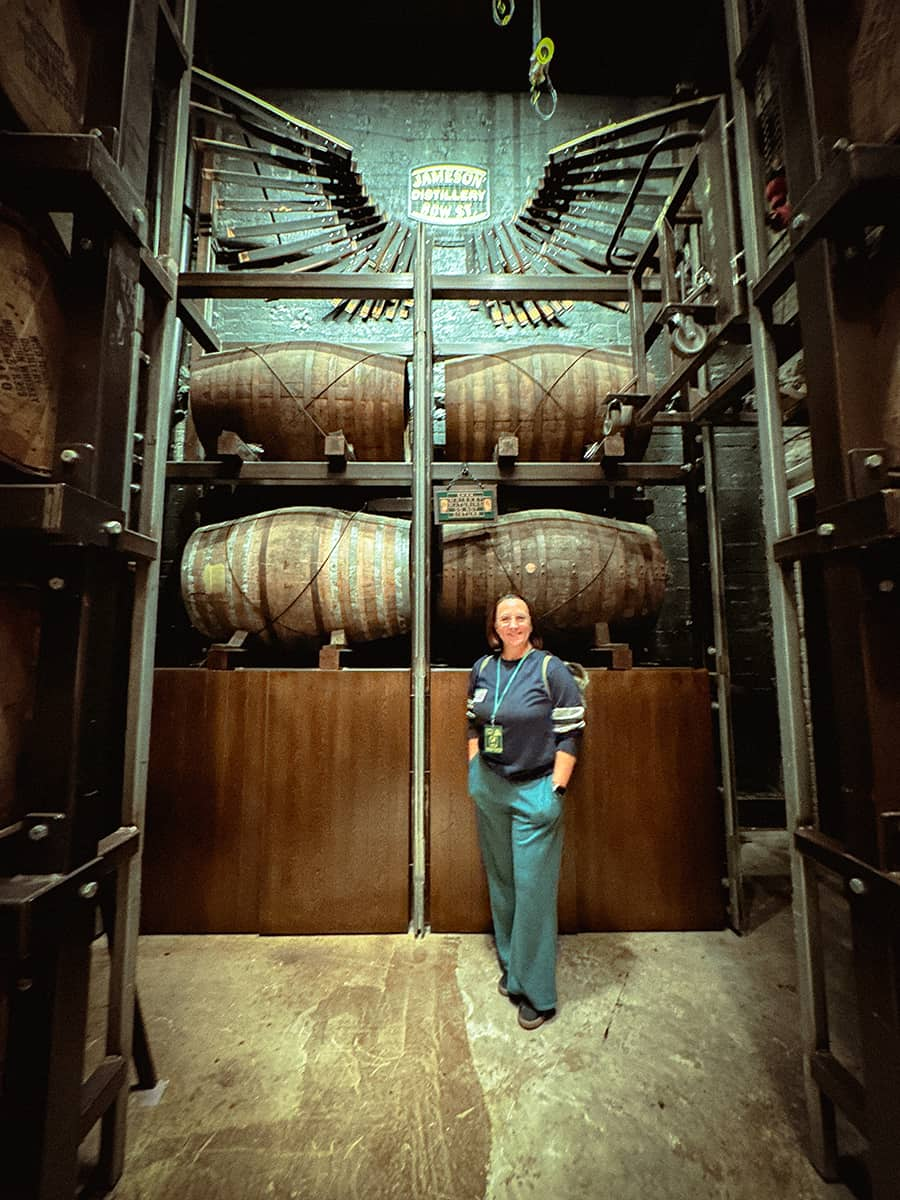
I added the cask-drawing experience for myself, and it was a highlight. Each adult participant has the opportunity to sample whiskey directly from a barrel, creating an Instagram-worthy moment.
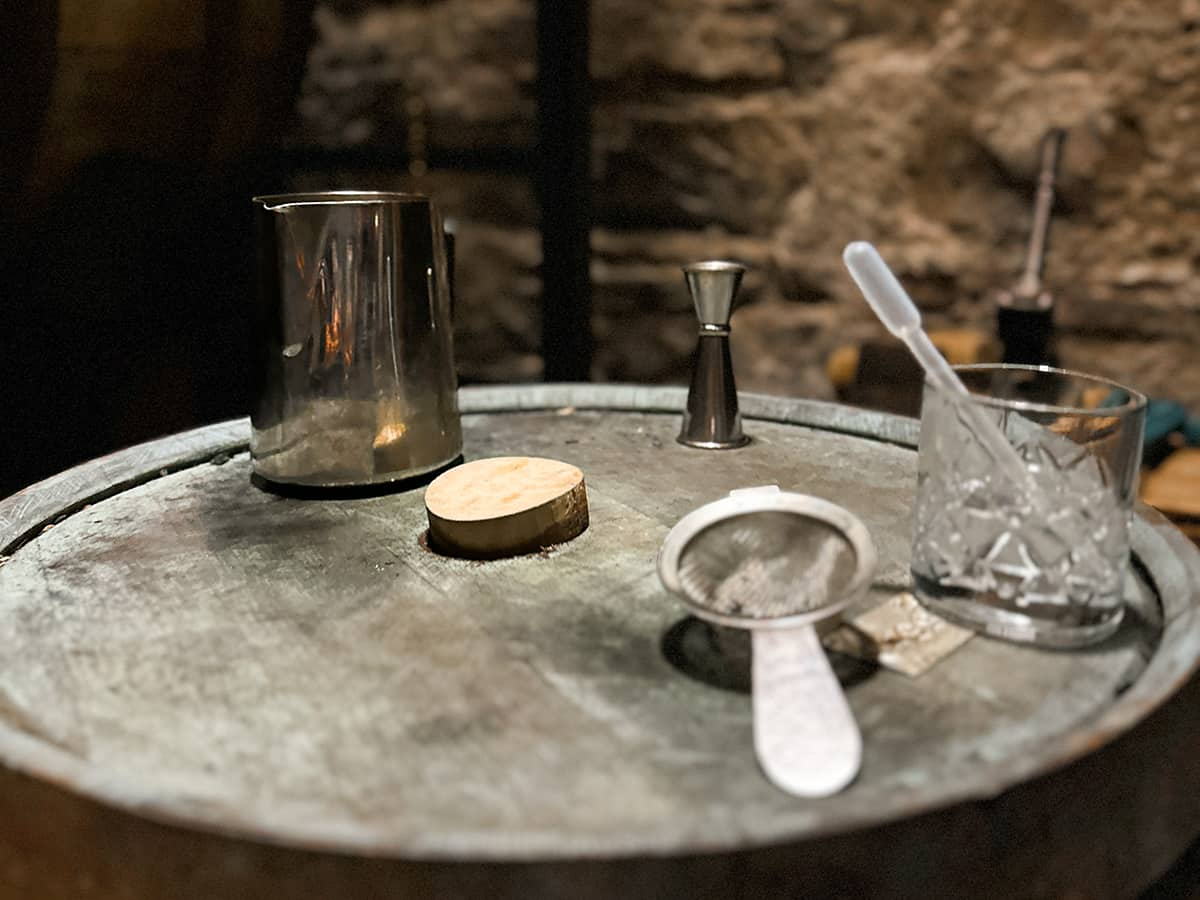
After the distillery, we set off on foot back toward our hotel, taking the longer scenic route that would lead us through several of Dublin’s distinct neighborhoods. This leisurely walk became one of our most rewarding experiences, proving that sometimes the best discoveries happen when you’re simply wandering with no particular agenda.
Walking Through Dublin’s Neighborhoods:
Our route from the Jameson Distillery in Smithfield back to The Mont Hotel took us through the historic Four Courts area, across the Ha’penny Bridge, and along the Georgian streets that make Dublin so photogenic. What started as simple transportation became an impromptu cultural immersion.
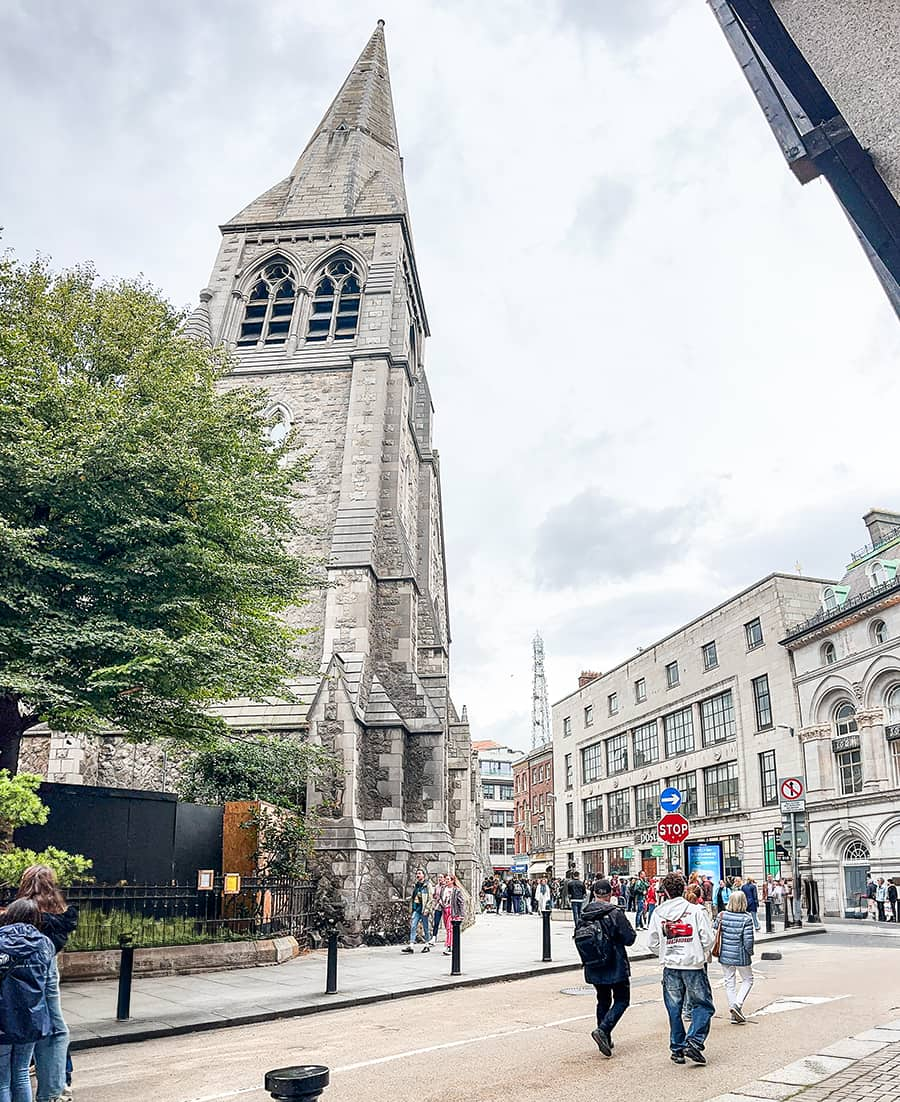
Free Discoveries Along the Way:
Georgian Door Spotting: Dublin’s famous colorful Georgian doors became an unexpected game for my family. We started photographing particularly striking examples, with each teenager claiming their favorite color and style. These doors, dating from the 18th and 19th centuries, provided a free outdoor architecture lesson that kept everyone engaged.
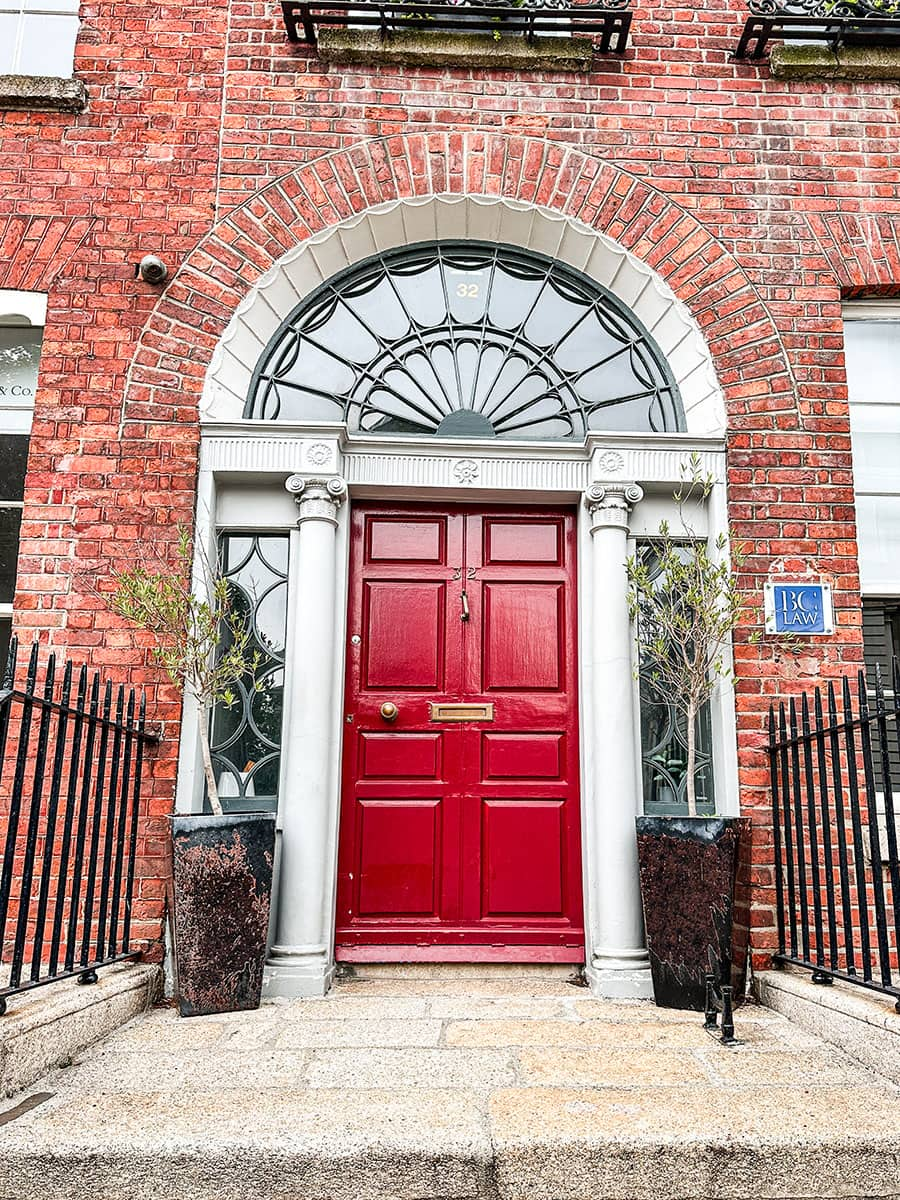
Merrion Square Garden (Free Entertainment): Our walking route naturally led us past Merrion Square Garden, one of Dublin’s most beautiful Georgian squares surrounded by elegant townhouses where famous writers like Oscar Wilde once lived. We spent 30 minutes exploring this perfectly manicured garden, but the real highlight was discovering a skilled performer practicing on a slackline stretched between two trees.
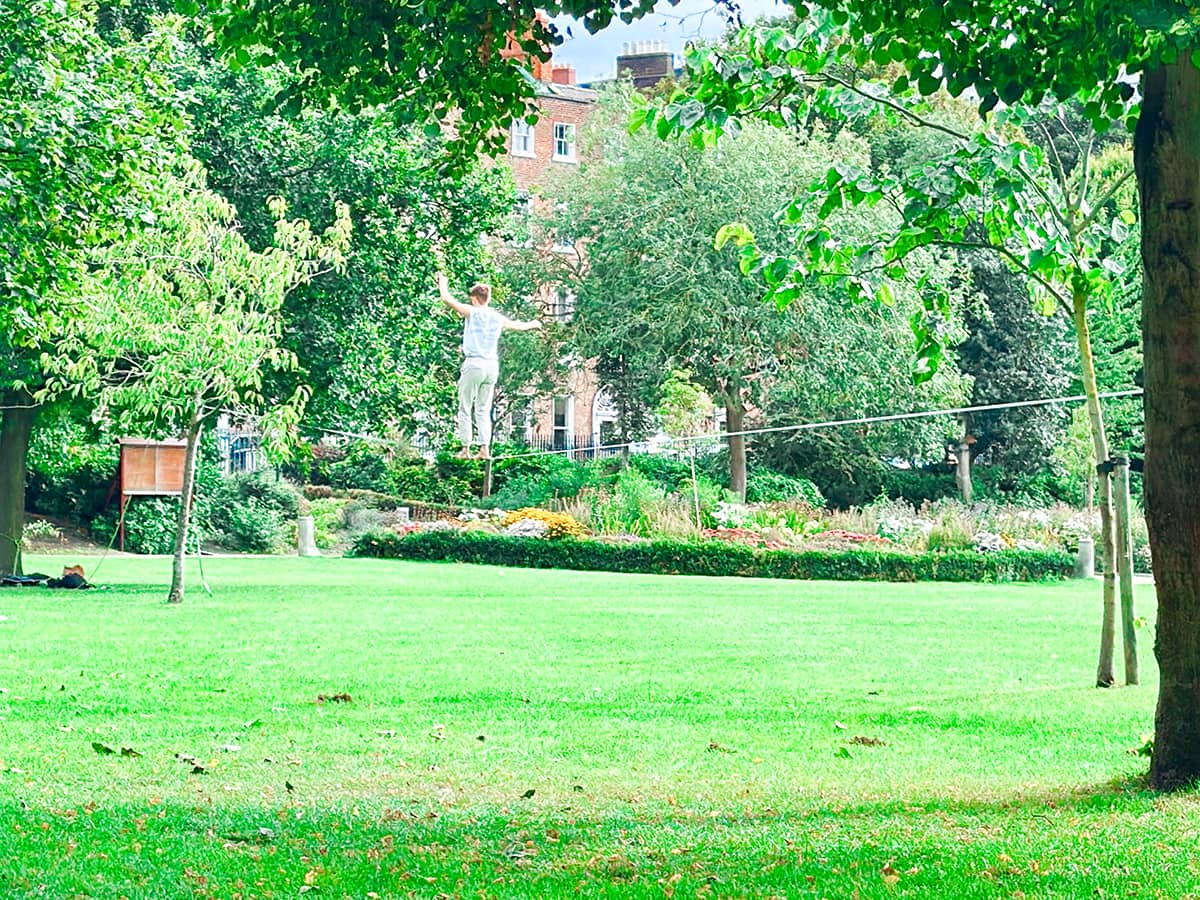
Day 2: Royal History at Dublin Castle, Temple Bar’s Cobblestones, and Grafton Street’s Evening Entertainment
Sometimes the best travel moments are completely unexpected. As we approached Dublin Castle for our morning tour, we discovered that Ireland was celebrating a national holiday honoring their emergency services. Instead of a quiet castle visit, we became front-row spectators to an incredible parade featuring emergency volunteers, ambulance services, and military units from across Ireland.
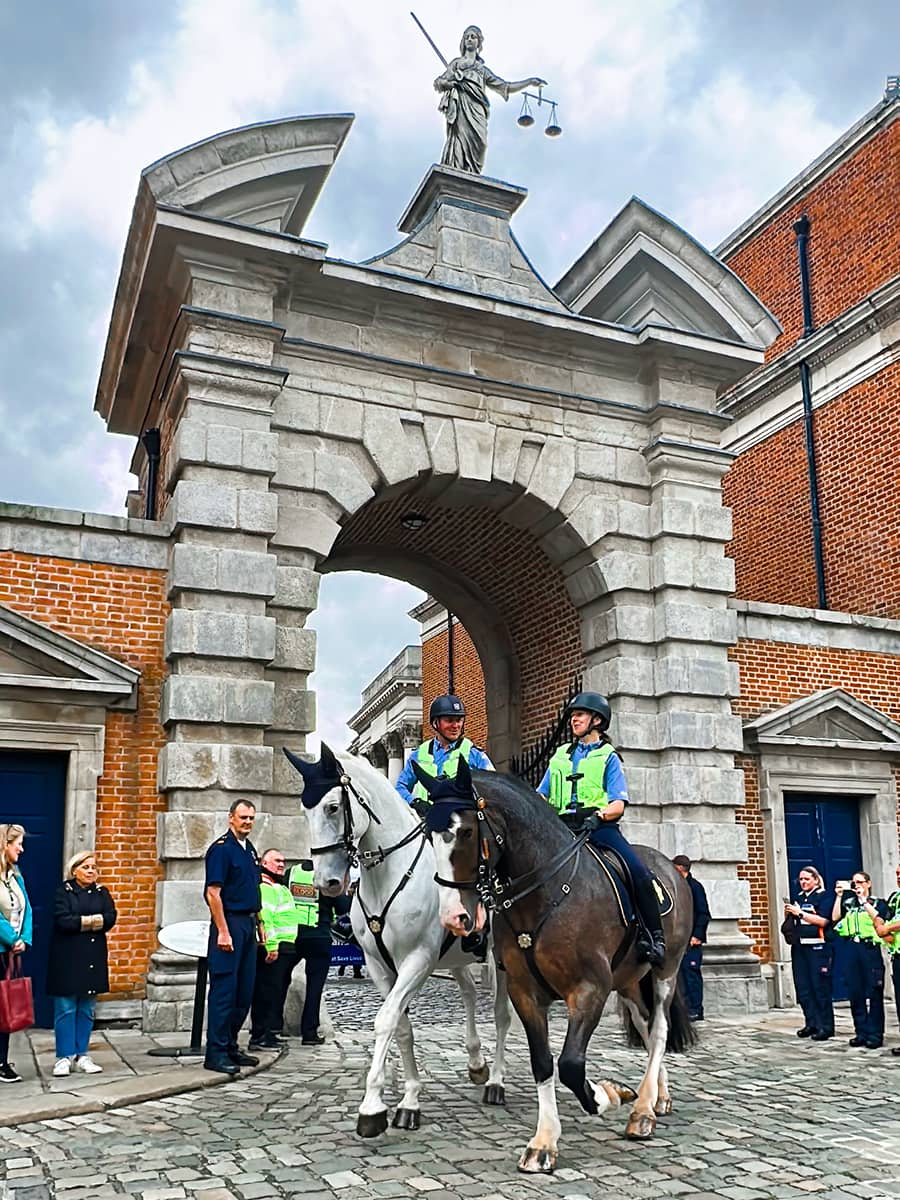
My teenagers, who I’d worried might find a castle tour “boring,” were absolutely captivated by the pageantry. We watched as bagpipe players strode past the castle gates, emergency service members in dress uniforms marched in formation, and the crowd around us swelled with locals celebrating their everyday heroes.
Check VisitDublin.com’s events calendar before your trip. Dublin frequently hosts festivals, parades, and cultural events that can add unexpected magic to your itinerary.
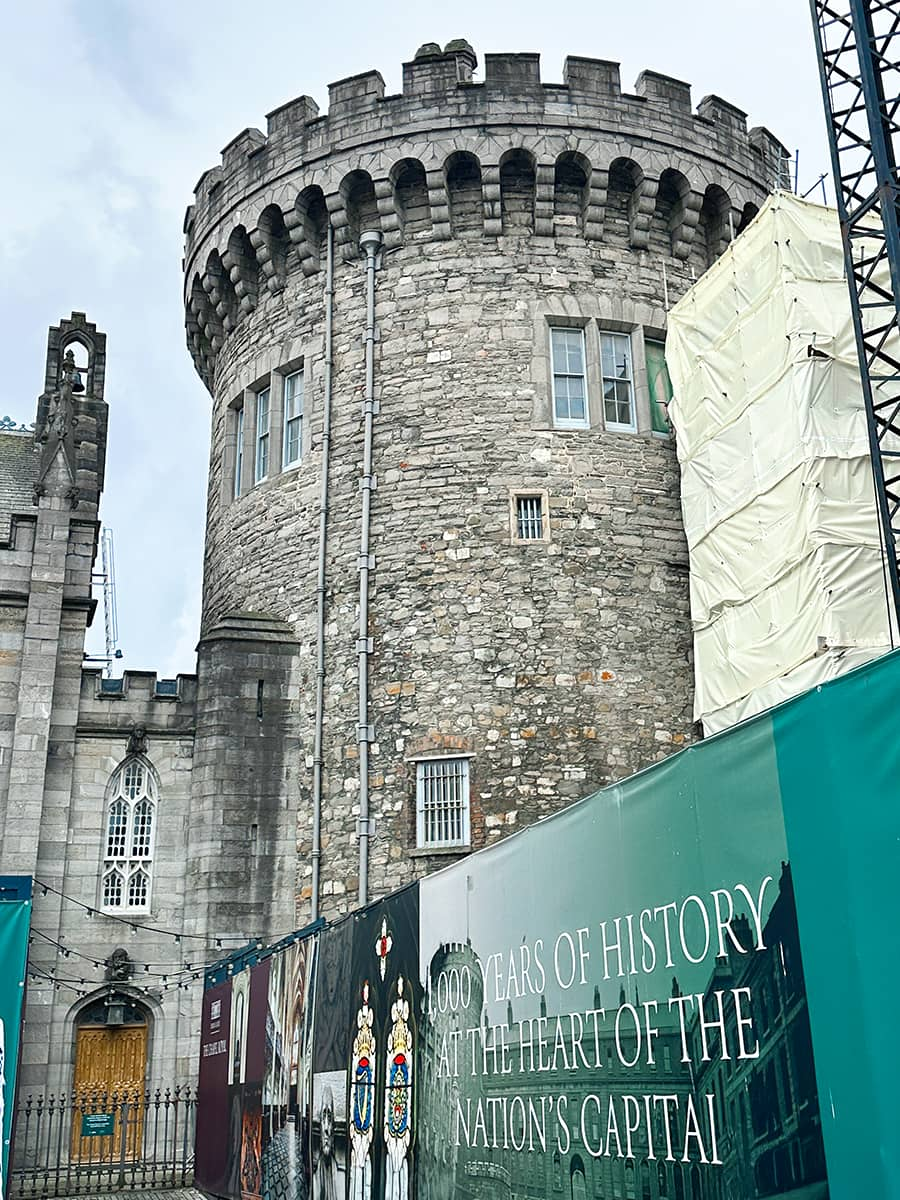
Dublin Castle: More Than Just Royal Rooms
Once the parade ended, our castle tour began, and it exceeded every expectation. The State Apartments are genuinely stunning, but what captivated my family most was our guide’s storytelling ability.
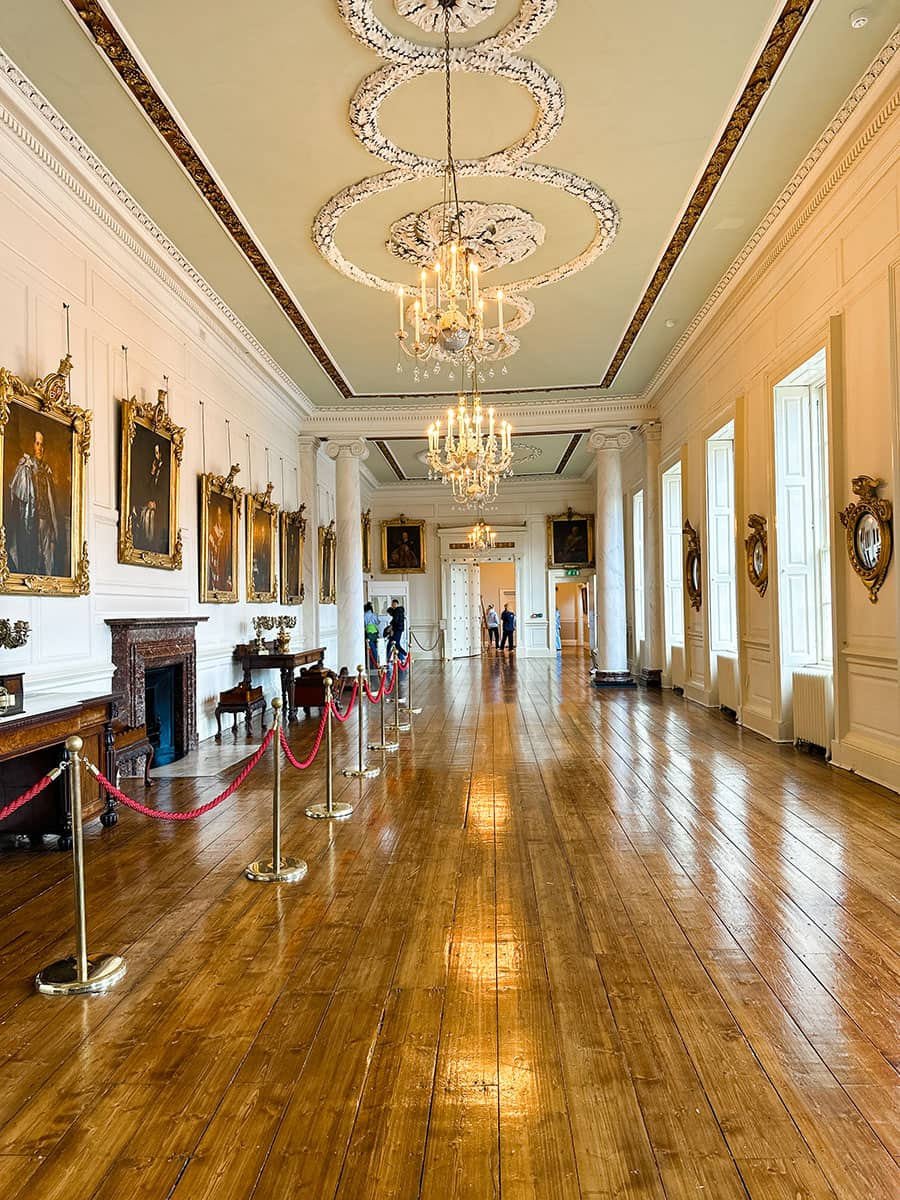
The most memorable story? During Ireland’s Great Famine (1845-1852), wealthy Anglo-Irish families continued hosting lavish dinner parties in these very rooms, using fresh pineapples as centerpiece decorations. Since pineapples had to be shipped from tropical colonies and cost the equivalent of hundreds of dollars each, they became the ultimate symbol of wealth and excess, while outside the castle walls, people were starving.
“Imagine,” our guide said, “displaying something worth more than most people’s annual income as a table decoration, while your countrymen faced starvation just blocks away.” Fellow tourists were visibly moved by this stark illustration of historical inequality. It sparked conversations with my children about social justice that continued long after we left the castle.
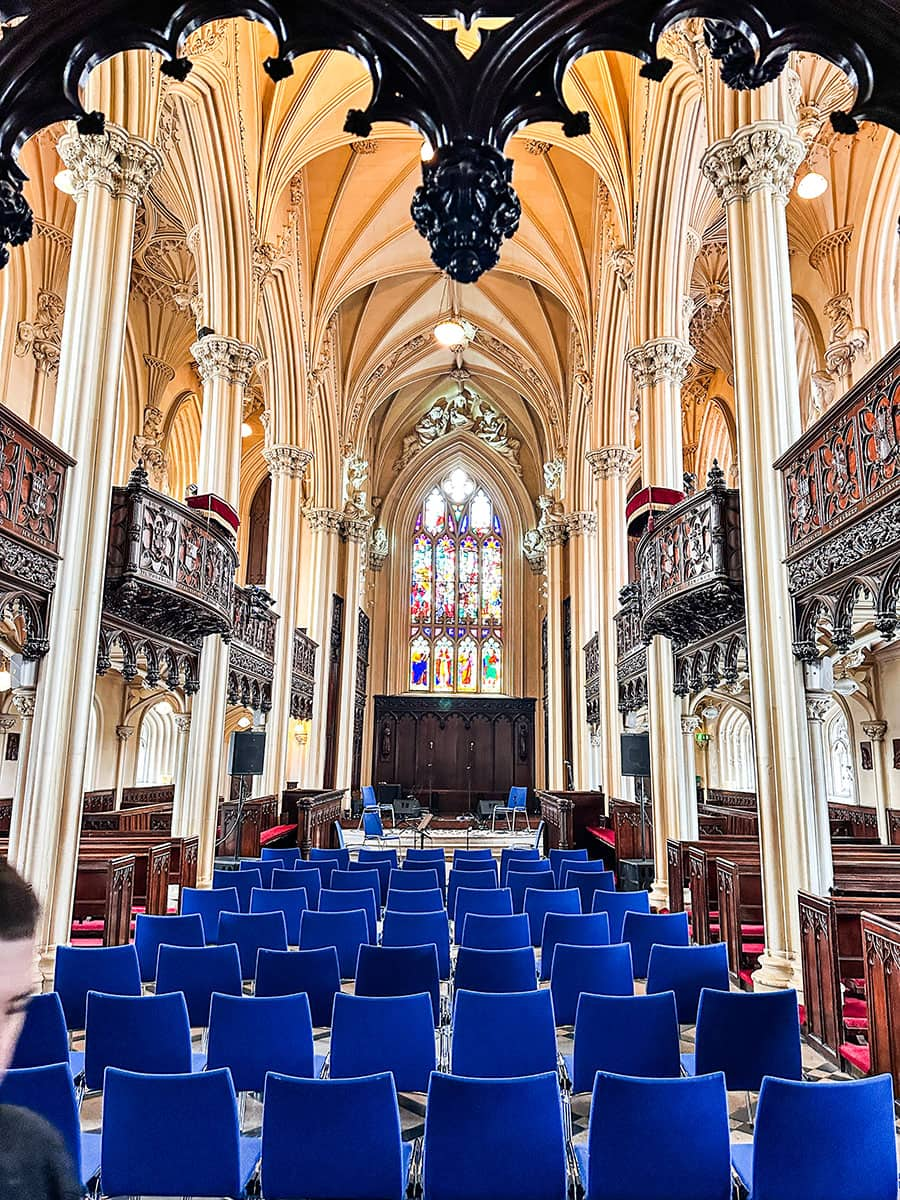
Teen Travel Tip: The castle’s medieval underground foundations and archaeological elements are particularly fascinating for teenagers interested in ancient history and archaeology.
Temple Bar During Daytime: A Different Experience
Most visitors associate Temple Bar with nightlife, but experiencing this historic quarter during the day offers a completely different perspective. Named for its location near the River Liffey (where “bar” refers to a riverside walkway), this area’s famous cobblestone streets lead visitors on a journey through Dublin’s cultural heart.
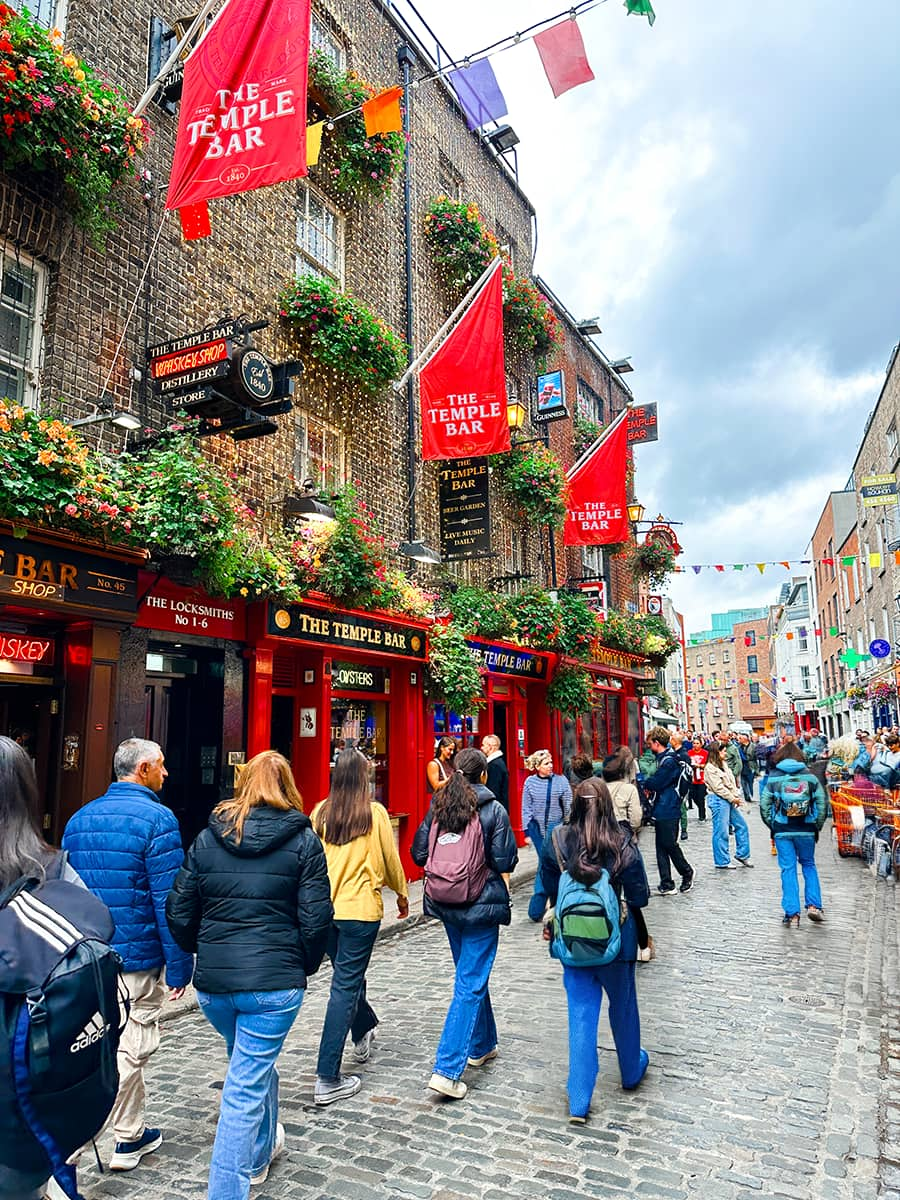
The cobblestone streets are less crowded during daylight hours, you’ll find live music in the bars, and the area’s artisan shops and galleries are actually accessible. Following these historic cobblestones as they wind toward the river creates a natural walking route that connects you to centuries of Dublin’s maritime and cultural history.
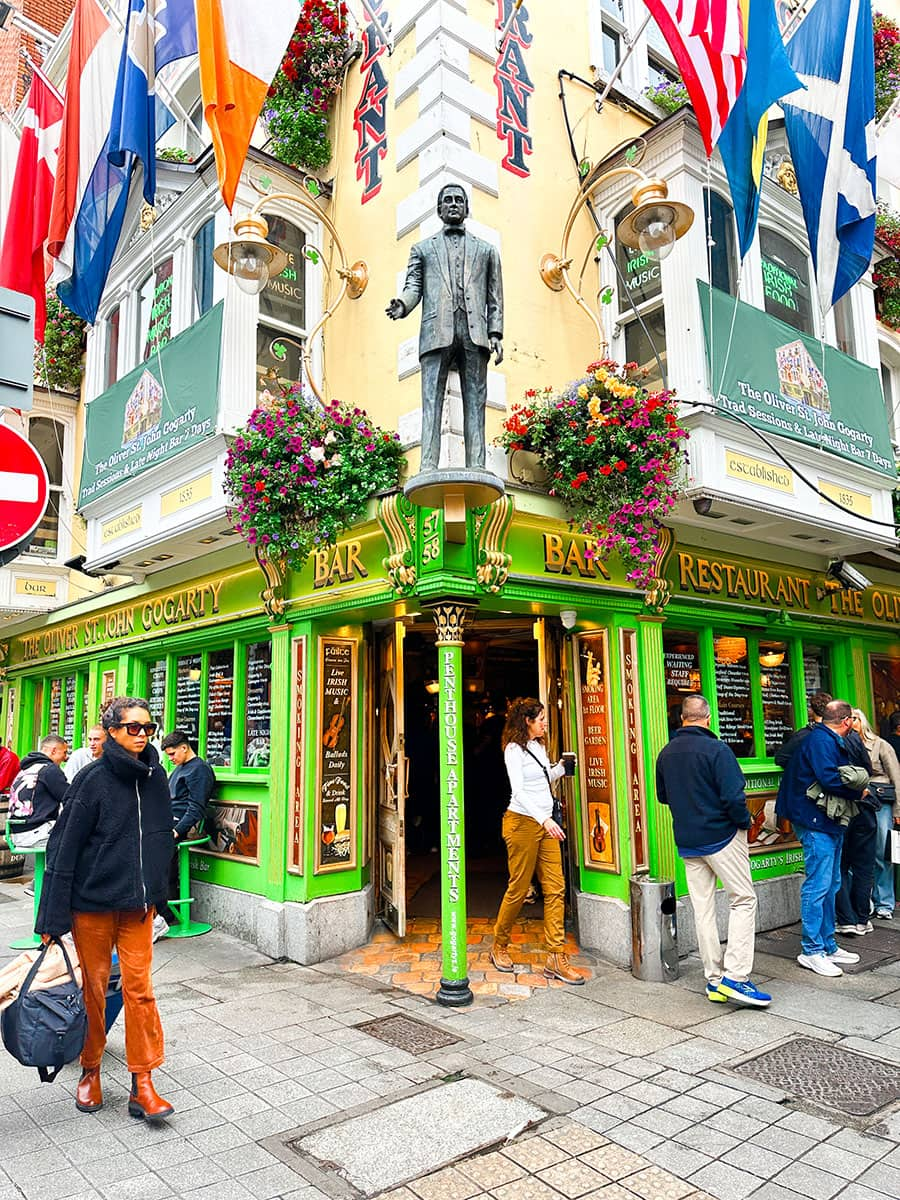
We loved browsing the stores, listening to live music, and photographing the colorful building facades without the evening crowds. We discovered several unique souvenir shops and even stumbled upon an impromptu traditional music session in one of the pubs that welcomed all ages during afternoon hours.
Grafton Street: Dublin’s Musical Main Street
As early evening approached, we made our way to Grafton Street, Dublin’s premier pedestrian shopping thoroughfare, and discovered why it’s considered one of Europe’s best busking destinations. The energy shift from afternoon shoppers to evening entertainment created the perfect atmosphere for our final Dublin city center experience.
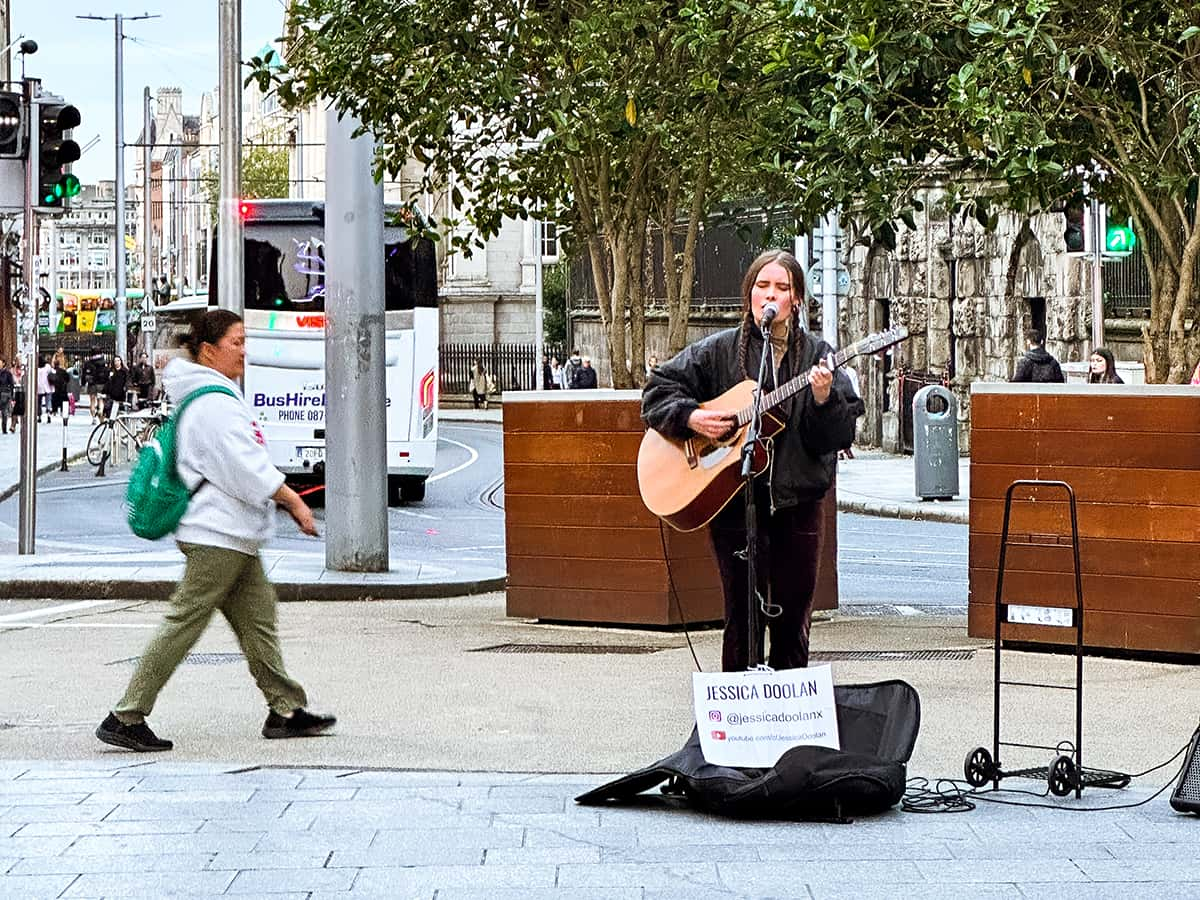
The Buskers of Grafton Street:
What makes Grafton Street special isn’t just the shopping—it’s the incredible street performers who transform the pedestrian zone into an outdoor concert hall. We encountered everything from traditional Irish fiddlers to contemporary acoustic acts, with each performer claiming their own section of the street and creating distinct musical neighborhoods.
Shopping with Teens:
Grafton Street’s mix of international brands and Irish boutiques provided the perfect shopping experience for teenagers. From Brown Thomas (Ireland’s most prestigious department store) to smaller Irish sweater shops like Aran Sweater Market, the variety kept everyone engaged. The pedestrian-only environment meant we could window shop leisurely without worrying about traffic or rushed sidewalk navigation.
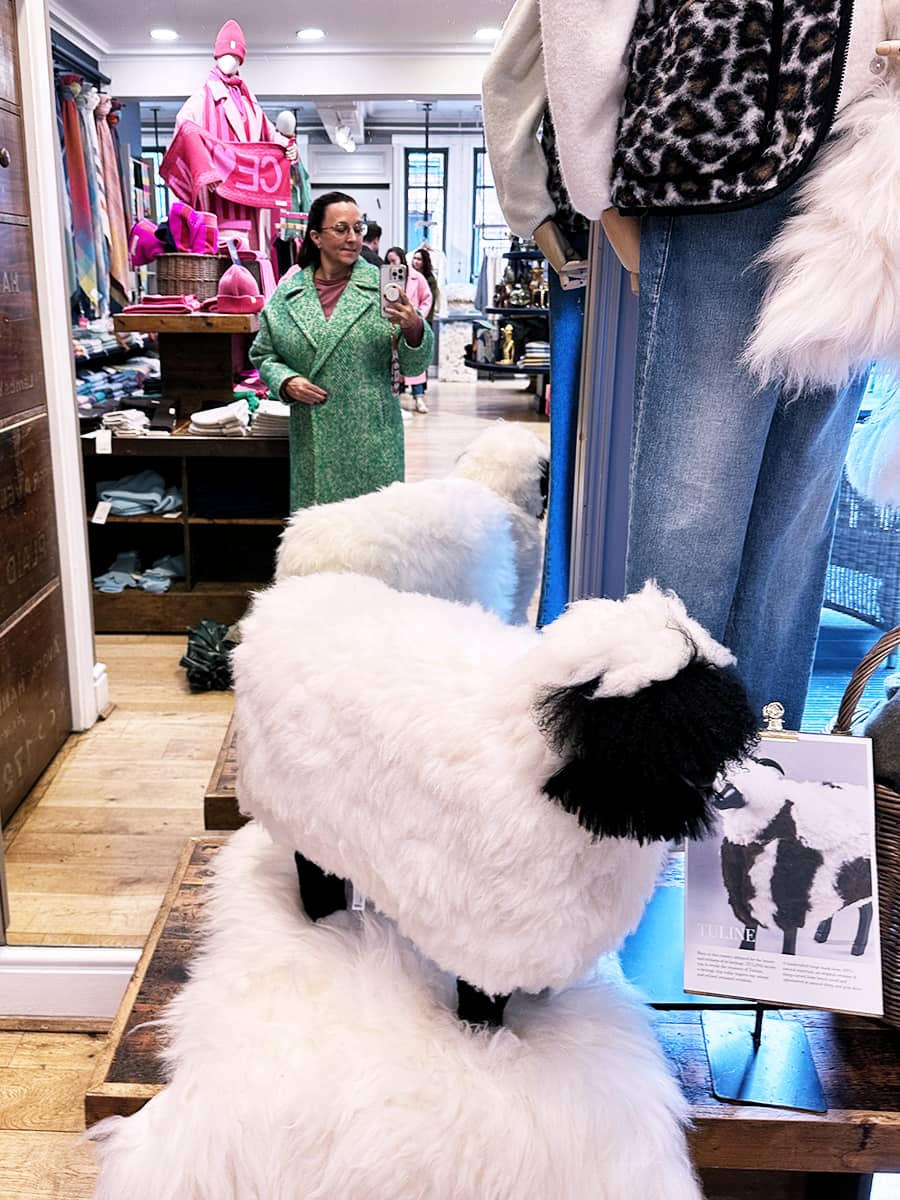
What made it perfect for our family:
- Free entertainment: The buskers provided hours of engaging performances without any admission fees. Tips are always welcome.
- Shopping variety: From souvenirs to serious fashion, something for every family member
- People watching: The mix of locals and tourists created a vibrant social atmosphere
- Easy navigation: The pedestrian zone eliminated safety concerns while allowing teenagers to explore semi-independently
Pro tip: Grafton Street connects directly to St. Stephen’s Green at one end and Trinity College at the other, making it a natural walking route that links multiple Dublin attractions while providing entertainment and shopping opportunities.
Day 3: Embracing Dublin’s Walkability
Our final full day in Dublin reinforced why choosing to explore on foot was perfect for our family. Armed with our Do Dublin Bus tickets, we initially planned to hop between attractions. Instead, we discovered that Dublin’s compact city center made walking not just possible, but preferable.
Dublin Public Transport: Available But Not Always Necessary
While Dublin offers excellent public transport—buses, trams (Luas), and trains—the city center’s walkability means you often don’t need it. Major attractions like Trinity College, Dublin Castle, Temple Bar, St. Patrick’s Cathedral, and the shopping districts are all within a 15-20 minute walk of each other.

That said, having Do Dublin Bus passes provided peace of mind and flexibility. When I got tired during our afternoon exploration, we could easily hop on a bus. The passes also enabled us to venture slightly further afield to neighborhoods like Smithfield (where Jameson Distillery is located) without the expense of individual tickets.
Bonus Discovery: The Do Dublin Bus tickets includes a scenic route to Dublin’s seaside areas, offering a completely different perspective of the city. This waterfront journey is a longer walk from the city center that many visitors want to experience, but the bus makes it easily accessible as part of your existing ticket. The contrast between Dublin’s historic center and its modern docklands development provides fascinating insight into the city’s evolution.
Trinity College and the Book of Kells: Literary History Comes Alive
No Dublin visit is complete without experiencing Trinity College and the Book of Kells, and this attraction proved why some tourist destinations achieve must-see status. The Long Room Library alone with its soaring 65-foot ceiling and 200,000 ancient books created an awe-inspiring moment that had all three of my teenagers actually putting down their phones.
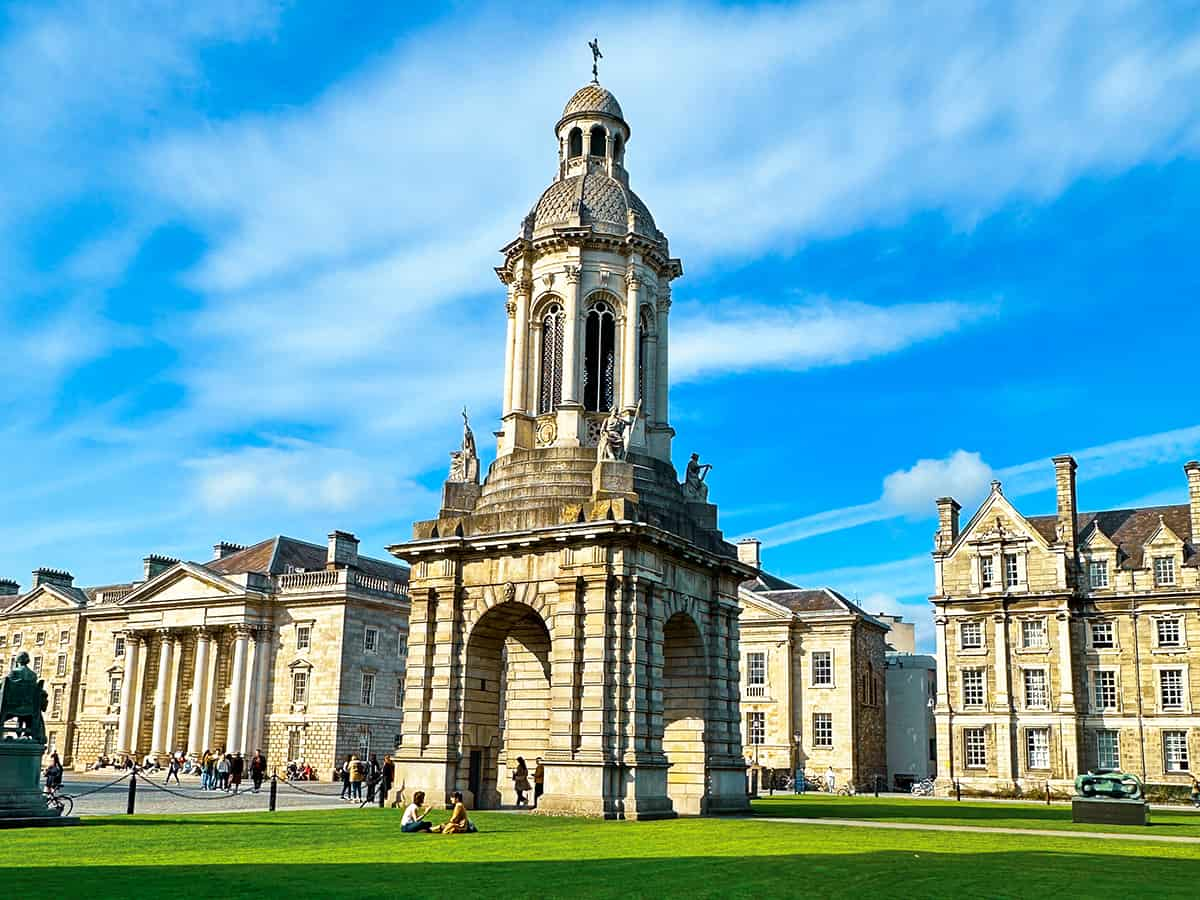
But Trinity College offers so much more than just the famous library. Strolling the campus grounds feels like walking through centuries of Irish intellectual history. The cobblestone pathways, perfectly manicured lawns, and Georgian architecture create an atmosphere where you can almost hear the footsteps of literary giants who once called these halls home.
Taking a guided campus tour transforms Trinity College from a beautiful university into a living literary museum. Our guide expertly wove together stories of the famous authors who studied here, bringing their personalities to life against the backdrop of the very buildings where they lived and learned.
Oscar Wilde strolled these same paths during his undergraduate years (1871-1874), developing the wit and aesthetic philosophy that would make him one of literature’s most quotable figures.
Note: If you or anyone in your family is a Wilde fan, add a visit to the nearby Oscar Wilde House. This house across the street from The Mont Hotel is where he grew up.
Bram Stoker, creator of Dracula, and Jonathan Swift, author of Gulliver’s Travels, wandered these grounds as students. Learning that Stoker and Swift walked the same paths we were exploring added layers of meaning to our Trinity experience.
Why the Campus Experience Works for Teenagers: Unlike many university tours that focus on admission requirements and academic programs, Trinity’s tours emphasize storytelling and creative inspiration. My teenagers, initially skeptical about visiting “some old college,” became genuinely engaged when they realized they were walking in the footsteps of authors whose works they’d studied in English class.
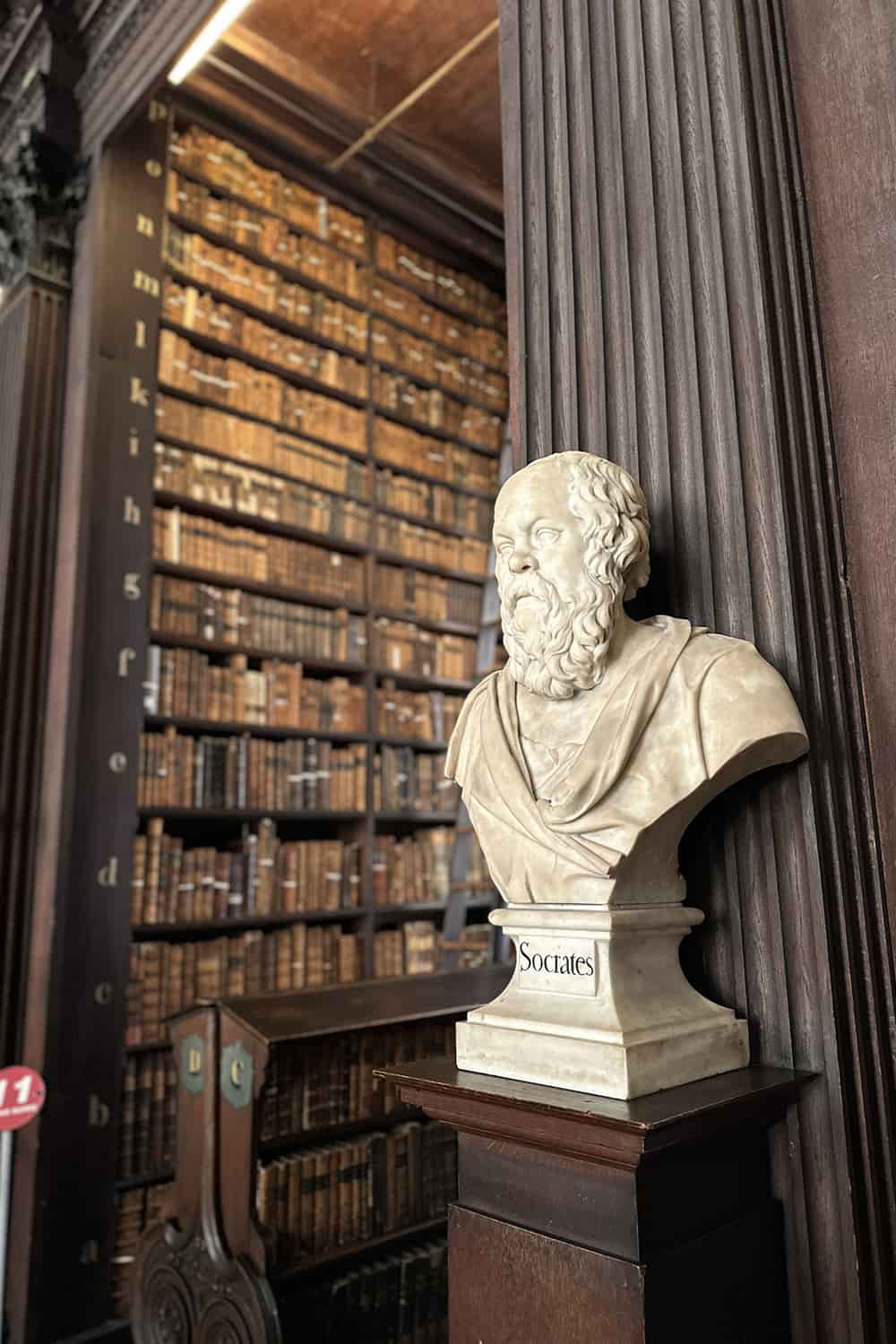
The Book of Kells exhibition skillfully balances historical education with visual spectacle. Even my most reluctant reader was fascinated by the intricate illuminated manuscripts and the story of how Irish monks preserved knowledge during Europe’s Dark Ages. Understanding that this magnificent book was created by scholars working in conditions similar to Trinity’s historic atmosphere added depth to the entire experience.
Pro Tip: Book the combined Trinity College campus and Book of Kells tour for the most comprehensive experience. The guided element ensures you don’t miss the literary connections that make Trinity special beyond its famous library.
Dublin as Your Irish Adventure Basecamp
One of Dublin’s greatest advantages for family travelers is its position as the perfect launching point for exploring the rest of Ireland. After our three days in the capital, we used Dublin’s excellent transport connections to continue our Irish adventure.
Transportation Options from Dublin:
To Belfast: We took the Dublin Express bus (2.5 hours, €20 per person) for a comfortable, affordable journey to Northern Ireland. The bus includes WiFi and comfortable seating, making it ideal for families.
To Galway: Regular train service (2.5 hours) connects Dublin to Ireland’s bohemian west coast city, perfect for exploring the Cliffs of Moher region. Our multi-day hiking tour with Wilderness Ireland Began/ended in Galway and really added to our love of the Emerald Isle.
Giant’s Causeway Tours: Multiple tour companies offer day trips from Dublin to Northern Ireland’s most famous natural attraction, eliminating the need for rental cars on challenging rural roads.
Wild Atlantic Way Access: Dublin serves as the starting point for organized multi-day tours along Ireland’s stunning western coast, from the Ring of Kerry to the Dingle Peninsula.
Cork and Southern Ireland: Frequent bus and train services make exploring Ireland’s food capital and the surrounding countryside easily accessible.
This hub-and-spoke approach to exploring Ireland worked perfectly for our family. We could fly into and base ourselves in Dublin’s comfort and amenities, before venturing off to experience Ireland’s diverse landscapes and cultures.
Why Visiting Dublin Without a Car is Perfect for Teenage Travel
After three days of car-free exploration, I can confidently say that ditching the rental car was the best decision for our Dublin adventure. Here’s why this approach works especially well for families with teenagers:
Cost Advantages: Between car rental fees, insurance, parking charges, and fuel costs, renting a car in Dublin can easily cost €250-300 for three days. Our combination of Aircoach transfers, walking, and Do Dublin Bus tickets costs about €145 total.
Safety and Stress Reduction: Dublin’s city center traffic can be challenging for visitors unfamiliar with driving on the left. Walking eliminated navigation anxiety and parking concerns while keeping our family together. We just had to remember to look to both ways before crossing the road.
Environmental Consciousness: Teenagers are often more environmentally aware than previous generations. Our low-carbon approach to exploring Dublin aligned with their values while demonstrating that sustainable travel can be convenient and enjoyable.
Authentic Experiences: Walking through Dublin’s streets provided countless opportunities for spontaneous discoveries; street art, buskers, local conversations, and hidden architectural details we would have missed from a car window.
Exercise Benefits: With teenagers spending increasing amounts of time on screens, our walking-intensive Dublin exploration provided natural physical activity disguised as adventure.
Essential Tips for Dublin with Teens
Weather Preparation: Irish weather is famously unpredictable. Pack layers and waterproof jackets for everyone. Comfortable walking shoes are absolutely essential.
Budget-Friendly Activities: Many of Dublin’s best experiences are free—walking the Georgian squares, exploring Trinity College campus (exterior), wandering through St. Stephen’s Green, and enjoying Temple Bar’s daytime atmosphere.
Teen-Approved Food: Dublin’s international food scene means even picky eaters will find options. From traditional fish and chips to international cuisines, the city center offers variety within walking distance.
Photography Opportunities: Teenagers love Instagram-worthy moments. Dublin provides countless photo opportunities—colorful doors in Georgian neighborhoods, the Ha’penny Bridge, Trinity College’s cobblestones, and Temple Bar’s street art.
Cultural Sensitivity: Use your Dublin visit to discuss Irish history sensitively, particularly regarding the complex relationship between Ireland and Britain. Teenagers often appreciate honest conversations about historical conflicts and their modern implications.
Departure and Final Thoughts
Our final morning at The Mont Hotel felt bittersweet—we’d fallen into a comfortable rhythm of walking Dublin’s streets, discovering new corners of the city, and feeling genuinely connected to Irish culture and history.
The walk to Custom House Quay for our Dublin Express bus to Belfast felt like a victory lap. My teenagers confidently navigated Dublin’s streets, chatted with locals, and had developed genuine appreciation for Irish hospitality and storytelling.
Would I recommend car-free Dublin exploration to other families? Absolutely. Our three days proved that slowing down, walking more, and embracing public transport can actually enhance rather than limit your travel experience.
Dublin’s combination of walkable attractions, excellent accommodations, and transportation connections makes it an ideal introduction to Ireland for families. Whether you’re planning to explore the rest of Ireland or focusing entirely on the capital, starting your adventure without the complications of international driving allows you to focus on what matters most: experiencing Irish culture, history, and hospitality with the people you love most.
Ready to plan your own car-free Dublin adventure? Start with central accommodation, book those key experiences in advance, and prepare for a city that rewards visitors who take the time to explore it properly one step at a time.
Want to Read More on Visiting Ireland? Start With:




